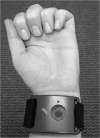Real-time mobile detection of drug use with wearable biosensors: a pilot study
- PMID: 25330747
- PMCID: PMC4371024
- DOI: 10.1007/s13181-014-0439-7
Real-time mobile detection of drug use with wearable biosensors: a pilot study
Abstract
While reliable detection of illicit drug use is paramount to the field of addiction, current methods involving self-report and urine drug screens have substantial limitations that hinder their utility. Wearable biosensors may fill a void by providing valuable objective data regarding the timing and contexts of drug use. This is a preliminary observational study of four emergency department patients receiving parenteral opioids and one individual using cocaine in a natural environment. A portable biosensor was placed on the inner wrist of each subject, to continuously measure electrodermal activity (EDA), skin temperature, and acceleration. Data were continuously recorded for at least 5 min prior to drug administration, during administration, and for at least 30 min afterward. Overall trends in biophysiometric parameters were assessed. Injection of opioids and cocaine use were associated with rises in EDA. Cocaine injection was also associated with a decrease in skin temperature. Opioid tolerance appeared to be associated with a blunted physiologic response as measured by the biosensor. Laterality may be an important factor, as magnitude of response varied between dominant and nondominant wrists in a single patient with bilateral wrist measurements. Changes in EDA and skin temperature are temporally associated with intravenous administration of opioids and cocaine; the intensity of response, however, may vary depending on history and extent of prior use.
Figures







References
-
- Harrison L.The validity of self-reported drug use in survey research: an overview and critique of research methods 1997. - PubMed
-
- Fletcher RR, Tam S, Omojola O, et al. Wearable sensor platform and mobile application for use in cognitive behavioral therapy for drug addiction and PTSD. 2011 33rd Annual International Conference of the IEEE Engineering in Medicine and Biology Society. 2011; 1802–1805. doi: 10.1109/IEMBS.2011.6090513 - PubMed
Publication types
MeSH terms
Substances
Grants and funding
LinkOut - more resources
Full Text Sources
Other Literature Sources
Medical

